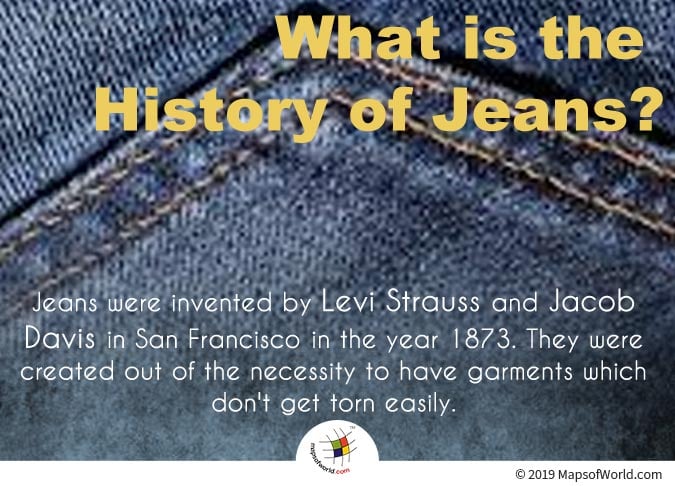

Jeans became a preferred Attire in the USA for Cowboys, Miners, etc in 1920s & 30s.
Jeans are a household item now…but how did it all start? Initially, they were rough and tough garments suited for men who had demanding jobs and were far from a fashion statement that they are today. Let’s see how they came into being.
Jeans were invented by Levi Strauss and Jacob Davis in 1873. They were created out of the necessity to have garments which don’t get torn easily. In 1851, Bavarian-born Levi Strauss came to New York to be a part of his brother’s goods store business. But in 1853 he went to San Francisco after he heard about the Gold Rush. Sensing a potentially profitable venture, he moved there to establish the family’s western business unit. He sold cotton cloth there among many other things. A tailor named Jacob W. Davis was one of his customers who used to make wagon covers, horse blankets, and tents.
One day, Davis got a request from one of his customers to make a sturdy pair of pants that won’t rip apart so easily even after some rough handling. He began the work using the cloth made from denim he purchased from Levi Strauss & Co. He ensured further strength by using copper rivets in places which are prone to tears such as the base of the button fly and pockets. The idea of riveted pants soon became a hit. So, Davis decided to patent the whole project. However, he needed a partner to ensure the project rolls smoothly. Levi Strauss seemed like an effective business ally to him. Davis wrote to Strauss expressing his ideas of patenting to which he agreed gauging the future growth in the business. On May 20, 1873, the two got a patent from the U.S. Patent and Trademark Office. That day is remembered as the birth of blue jeans. Together they opened a big factory and the official sales of jeans started.
In the 1920s and 1930s, jeans became a preferred attire in the USA for cowboys, miners or any worker who needed strong clothes. And in 1936, Levi Strauss did something which no designer had done before. He added to the jeans’ back pockets his signature red flag. Jeans thus became the first clothing ever which had a designer label outside. In the 1930s Vogue Magazine featured its model in jeans on the cover, sparking ideas that jeans could be a fashion statement as well other than being a robust garb for the workers with laborious jobs.
The fever of jeans caught on, especially after Hollywood projected them as a fashion symbol. Pop culture icons Marlon Brando and James Dean wore denim and popularized the clothing even more. Expectedly, teenagers were in love with the jeans. Black jeans, cuffed denim styles, and light washes were the reigning trends. At that time, popular brands were Levi’s, Wrangler jeans, and Lee Cooper among others. However, that was only for men. Women didn’t embrace the idea of jeans until the 1960s.
The 1960s witnessed the beginning of the hippie age. Jeans were seen as the symbol of freedom from more traditional structured clothing. The idea to personalize your jeans with creative ideas was very much in fashion. Using embroidery, patches, rhinestones, and stone washing were burning trends. Double denim too appeared in this decade only.
In 1970s jeans again began to be seen in a more conventional light rather than as a rebel or hippie symbol. Movies like Charlie’s Angels morphed the public opinion into seeing jeans as a de facto fashion statement. Denim vests and skirts were also becoming popular.
These were the years when jeans got their real designer makeover. Brooke Shields featured in a Calvin Klein ad saying “Nothing comes between me and my Calvins.” This put the first seeds into the minds of fashion designers to turn jeans into frontier fashion clothing. Soon, designers’ jeans became part of the popular culture. Ripped jeans, acid wash, and skinnier leg cuts were the desired looks. Gloria Vanderbilt, Jordache, and Calvin Klein were popular brands among young guys and girls.
In the 1990s, jeans turned more casual. They were no longer an attire used for dressing up. Denim shortalls and overalls, head-to-toe denim ensembles, and jeans with multiple tabs & pockets become trendier among young women. Baggy jeans became a favorite among men with the rise of hip hop.
Christina Aguilera and Britney Spears made ultra-low-rise jean popular in the early 2000s. Jeans were so popular that they were considered an item of clothing to wear at work or on a Saturday night. For the early 2000s, flare and boot cut jeans also ruled the market. As the innovations happened in the denim stretch technology, skinny jeans arrived on the scene. They were considered so fashionable that everybody was wearing them whether it was work or dates. Boyfriend jeans was another hot trend. New brands like Hudson Jeans, Citizens of Humanity, and 7 for all Mankind were household names in the 2000s.
Skinny styles have continued in the years beyond the 2010s as well. They’re both dressy and casual nature helped them stay popular. Straight leg jeans, high-waisted jeans, denim overalls, jumpsuits, and rompers are all popular trends. And so are distressed denim and ultra-shredded denim styles.
Related Links:
The Republic of Madagascar is an island country located in the Indian Ocean, off the…
The Euro is the official currency of the European Union. It is, however, not incumbent…
There are many countries or regions that are partially recognized by the UN, have disputes…
The Alaska Statehood Act was signed into law by President Dwight D. Eisenhower in 1958,…
The name Persia may, however, only be used to refer to Iran in some contexts.…
Hawaii is an Island State in the US. It is one of the 50 states…